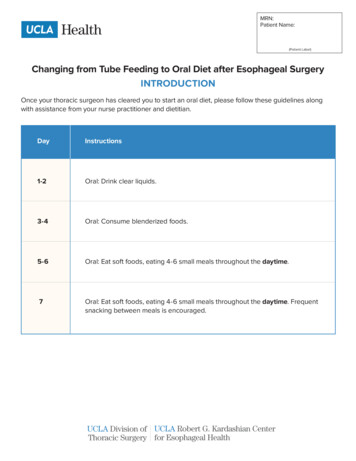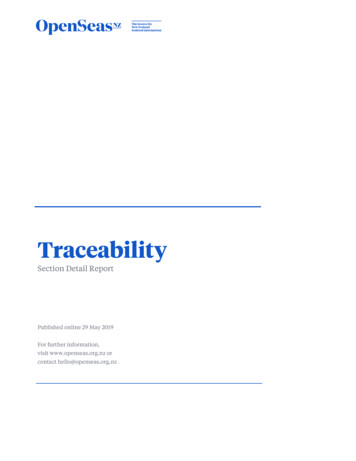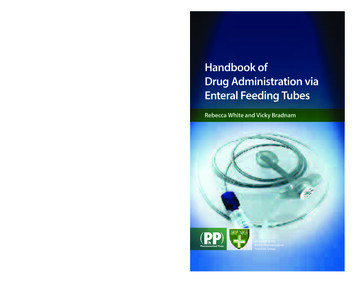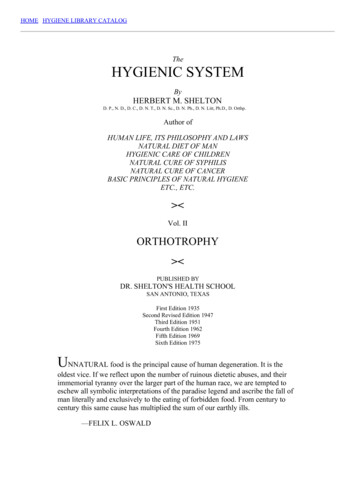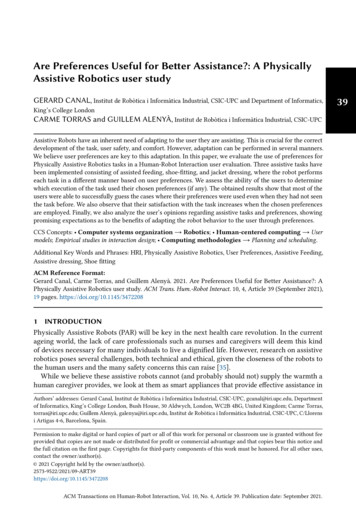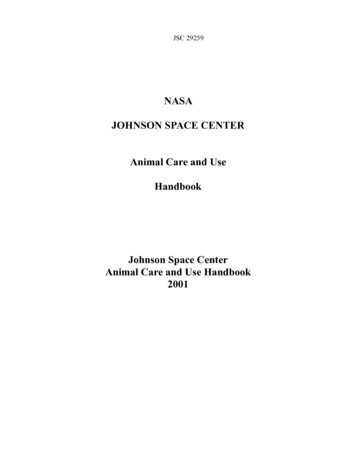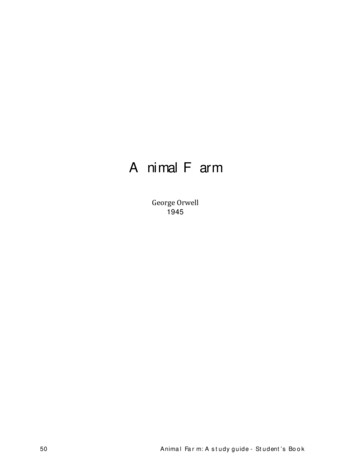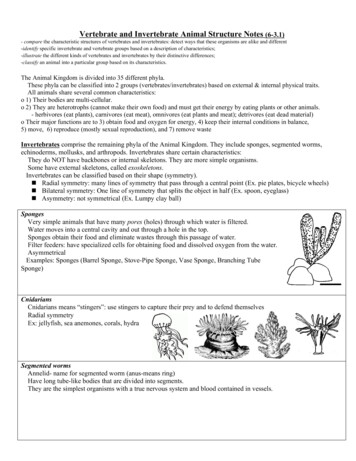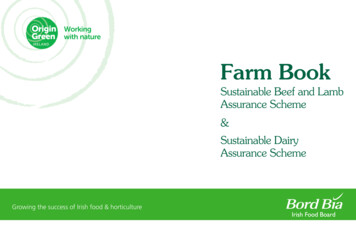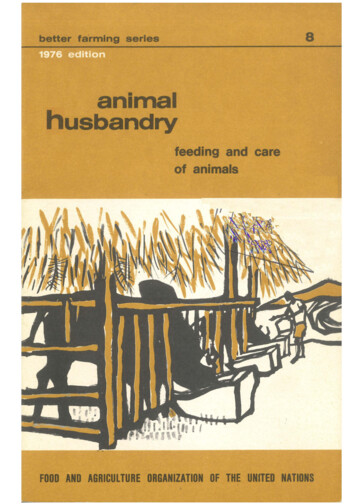
Transcription
8better farming seriesanimalhusbandryfeeding and careof animalsFOOD AND AGRICULTURE ORGANIZATION OF THE UNITED NATIONS
ITn -sixes hen published indesigned as handboor aar iI el agricuI education andiniThey may be puased as ardocuments.1.2.3.4.5.6.7.8.9.isries,The plant the living pla ;e roothe plant the stem; the buds; the leavesThe plant: the florThe soil: ho the soil is made upThe soil: ho to conserve the soilThe soil: how to improvee soilCrop farmingnimal husbandry: feeding and care of animalsnimal husbandry: animal diseases; how animalsreproduce10. The farm business survey11. Cattle breeding12. Sheep a,nd goat breeding13.eping chickensFarming with animal power15. Cereals16. oots and tubers17. Groundnuts18. ananas19. Market gardening20. Upland rice21. Wet paddy or swamp rice22. Cocoa23. Coffee24. The oil palm25. he rubber tree26. The modern farm business
1I"'I"'Published by arrangement with the.institut africain pour le deve1oppement economique et socialB.P. 8008, Abidjan, Cote d'IvoireFOODAGRICULTURE ORGANIZATION OF THE UNITEDRome 1976
0 Economic and Social Development SeriesNo. 3/8First printing 1970Second printing; 1972Revised edition 197-6lSBN 92-5-10014 7-2 French edition, I nstitut africain pourle developpement economique et social ( I NADES) 1970 Engfish edition, FAQ 1976
This manuala transiationievage le soin des , imau " putheof the lnstitut africain pourdeveloppeeconomique etI (IESL- and forms partof a series ofkiets. GI acknowiedgementmade to the publishersr making available this text,which it is hoped will find widespread use at the intermediatelevelagricultural education and training in English-speakingcountries.The original texts were prepared for an African environmentglish version. However,and this is naturally reflected in theit is expected that ·many of the manuals of the series - alist of which will be found on the inside front cover - willalso be of value for training in many other parts of the world.Adaptations can be made to the text where necessary owingto different climatic and ecological conditions.Applications for permission to issue this manual in otherlanguages are welcomed. Such applications should be addressedto: Director, Publications Division, Food and AgricultureOrganization of the United Nations, Via delle Terme diCaracalla, 00100 Rome, Italy.The author of this English version is Mr. A.J. Henderson,former Chief of the FAO Editorial Branch.
hhmu5'' . ''' . '.'. ' . ''. 8animal h . , , . 10Why animals must be well fed .How food is used in the animal's body .Not al! animals digest food in the same way .How to choose an i ma Is' food .10111213Foods that give nitrogen must be chosen .Values of certain foods .What is a mineral supplement?.i tam ins . . . . . . . . . . . . . . . . . . . . . . . . . . . . . . . . .Giving the animals water to drink .1416171718Food needs of animals . 20How to feed animals . . . . . . . . . . . . . . . . . . . . . . . . . . . . . . . . . . . . . . . . 24Improving pasture . .Making new pasture . 25Using new pasture . 26Growing fodder crops . 27Storing grass . 28Si iage . 28Hay . 29 an· · · · · · ·. · . 31Animals must be watched . 31Housing animals . 34. 37somequestion paper . 381
Efl4 toaIk roundsrllageERead pages 10 to 23.This is a difficult lesson.You have to understandthe needs of animalsand the value of foods.Don't hurry.Reread the lesson several times.2seeanimals are used
EERead pagestoReread pages 10 toow canmake better use of pasture?Do you make hay or si Iage?Where do your animals drink?ERead pages 31 to 36.Reread carefully the whole course.It is very long,but it is very important.Making a shelter for the animalsdoes not cost much.It is made with things you can get in the village.Don't answer the question paperunti Iunderstand the course.Don't hurry.3
They usually keep chickens and goatsaround the house.They often have sheep and cattlewhich roam about freelyor are in the carea keeper.in dry regionsthere are donkeys, horses and camels.I these animalsare raised and used as they always have been.imal husbandry.This is cal led,,,imalsmthen the farmerways,mGo in for modern iYou will have more animalsand fatter ones.You wi II get more money for themif you sel I them.You will make a bigger profit.4
now and thenthe farmer kills a chicken, a duck,a goat, a sheep or a pig,in order to eat it.If he has no animals,he buys meat on the market.Some people drink a lot of milk.milkeggsrich foodwhich contains a lot of proteins.Proteins are a food that people need.To eat enough proteinsmeans good health.People who don't eat enough proteinsare often ill or don't grow big.Proteins help to build up a man's bodyand give it strength.Proteins from animalsare a food that people needin order to grow,become strongand stay in good health.5
a birth,a marnage,a funeralor traditional feasts,or when strangers come as guests,people often kill some animals:chickens,goats,sheep,cattle.So the farmer often needs animals.hiaimals are often a store of wealth.For example, in Maliwhen the stores of millet are about toa farmer sells his milletand buys some animals .bad,When the farmer needs money,either to pay his taxesor for a dowry or some feast,or to buy something,he sells one or more of his animals.Animals are wealththat you can either show or hide.If you want to show your wealth,you can keep them near the vi Iiage.If you want to hide your wealth,you can get someone to keep them for youfar from the village.6
has weabut does not look after it.It does not require much work,doesbring in muchOften, animals are not milked.If they are mi I ked, it may be the herdsmanwho drinks the milk or sells it.Many animals diebecause they are badly fed,or because disease ki I ls them.Un less they are we! I watched,flocks and herds stray into the fieldsand ruin the crops. A man who owns a cart,but goes on carrying his produce on his head,owns a working tool, a means of wealth,but he does not use it.A man who owns some bank notesand keeps them in a jardoes not make his money produce anything;he lets his wealth lie idle.A man who owns animalsand does not look after themlets his wealth lie idle.The cart,the bank notes,the animalsare wealth,they are capital.It is no good letting capital lie idle.Animals are a capitalthat should produce as much as possible.7
Traditional animal husbandry is useful,but it produces little and earns little.Modern animal husbandcan produce more and earn much more. Well-fed animals grow more quicklthey become bigger,yield more . ,"'-.They can be sold at a better price. Well-fed animals give more mi .The young animals are in better health.The milk can also be sold or drunk. Wei.I-trained animals can be harnessedand help you to farm bigger fields.They help to carry wood, water, harvests.You have more time for farming,your fields wi II be bigger and better worked. Animals produceYour soil will become richer and better.Your harvests will be better.You wi 11 make more money. Animals that are well fed and looked afterare healthy.They have more young onesand your herd wi II be better and bigger.You Ccln sell animals and earn more money.Animal husbandryis a capitalthat can produce a lot.8
IIf animal huuce min a different wa He must both grow cropsand look after his animals.there were people who grew cropsIn the old daand people who raised animals.Those who grew cropsdid not gQ in for animal husbandry,ose who raised animals grew no crops.andToday the same manmust both grow and raise animalamm especially thenq animals;he must lay in reserves for the dgive the animals enough to drink .season, build a shelter for them,protect the animals against parasites and diseases,look after them if they are hurt . make manure,train oxen,choose the best animalsfor meat, milk and work.9
chi Id that does not eat welldoes not grow well;it is often ill.man who does not eat wellcannot do much work;he is not strong,he is often i 11.It is the same with animals.badly fed calfdoes not grow well;it is often illand often it dies.badly fed cowdoes not produce big calves;she cannot feed them well.A farmer who feeds his animals wellmakes more money.Animals changecheap food that is drfficult to carryinto other more costly foods that are easy to carry.For example:grass, over-npe yams,grain that is broken or eaten by insects,the remains of the family's food,are changed intomilk, meat, work and young ones.10
IIIWhen the animal eats,the food goes into the dIn the !ract the food is changed and dThe digested part of the foodenters the blood to feed the body.The rest is rejected asoru:!! 'li"OrllWhen the greater part of the foodenters the blood,the food is said to be rich.When the greater part of the foodis rejected,the food is said to be poor.Examples: Millet is rich food for certain animals.They can make good use of it.The greater part of it enters the bf ood.One kilogramme of crushed milletcan give an animal's body as much strengthas six kilogrammes of grass. Hard, stringy grasses in the dry seasonare a poor food for animals.The greater part of the dry grassdoes not enter the blood;it is rejected.11
IIChickens, cows, pigsdo not eat the same food.These animals have different stomachs;they do not digest in the same way.That is why they do not eat the same things.Sheep, goats and cowseat the same food.These animals have the same stomachs.Chickens and duckseat the same food.Entry of foodEntry of foodSecond stomachThirdstomach- Path of foodstomachExit of foodPig stomachCow and goat stomachIn one and the same herd of cattlethere are often animals that eat the same foodbut do not grow in the same way.They eat the same foodand have the same digestive tract,but some use their food better than others.12
Many experiments haV,e shownthat a cow which eats l kilogramme of paddy(unhusked rice)can give as much milkas a cow which eats 6.5 kilogrammes of grass. Other experiments have been madefor every kind of food for animals.These experiments have shownthe amount of each foodwhich has the same value as 1 kilogramme of paddy1 kg of paddy is usedvalue of foods.1 kgmeasurepaddy is called a fodder unit or feed unit.of paddy (unhuskedrice)of cottonseedcakeof grass1 kg of paddy,1.6 kg of cottonseed cake,6. 5 kg of grasshave the same food value.They give 1 fodder unit.r3
EI EEETo live, plants take out of the soil mineral saits(see Booklet No. 6, page 10)which contain nitrogen, phosphorus, potassium.Different plants have different needs(see Booklet No. 6, page 14).All plants do not have the same needof the same amount of mineral salts.Animals too have different needs. They need foodthat gives them strength and energy;these are ca I led energy foods.For example: maize, cassava. They need foodto make their muscles and their meat.These are nitrogenous foods,foods that contain nitrogen.For example: oil cake.Modern farmers put fertilizers on their fields.Fertilizers complete the plants' food.Modern farmers who raise animalsalso complete the food of their animalsby giving them, as well as energy foods,foods that contain nitrogen.These foods are called feed supplements.With nitrogenous foods an animalgrows better and produces plenty of meat.Food rich in nitrogenis cal led a protein-rich food.Feed supplements, like fertilizers (see Booklet No. 6,page 14), are costly.farmer must choose the right feed supplement.14
Many experiments have made it possible(nitrogen)the amount ofwhich each food contains.The foods which are richest in nitrogenare oil cake, meat meal and fish meal,and milk.305 grammes300 grammes69 grammes17 grammesGrassMaize grainMilkOil cakeThe amount of digestible protein (nitrogen) in 1 kg of food.In the same way as for fodder or feed units,tables have been made which showthe amount of digestible proteinin each food.Other tables have been made which showthe protein needsof each kind of animal.Animars make good useof energy foods and body-building foodsif they are given mineral saltsand clean water at the same time.15
F Ea valueGrass and silage (see page)of 1 to 2 fodder unit.Five to ten kilogrammesgrass or silage are neededto give the value of 1 fodder unit.One kilogramme of grass or silagecontains between 10 andgrammesprotein.Hay has a valueof 0.3 to 0.5 fodder unit.Two to three kilogrammes of hay are neededto give the value of 1 fodder unit.One kilogrammehaycontains between 25 andgrammes of protein. Oil cake has a valueof 0.5 to 1 fodder unit.1.5 kilogrammes of oil cake are neededto give the value1 fodder unit.One kilogramme of oil cakecontains between 150 and 400 grammes of protein.Grains have a valueof about 1 fodder unit.One kilogramme of grain is neededto give the value of 1 fodder unit.One kilogramme of graincontains about 50 grammes of protein.Tubers have a valueof 0.3 or 0.2 fodder unit.Three to five kilogrammes of tubers are neededto give the value of 1 fodder unit.One kilogramme of tuberscontains between 7 and 9 grammes of protein(see the table on page 37).16
llISEmineral. supplementgives m1Animals as well as plantsneed mineral salts.You can give mineral saltsby putting salt in the drinking water or in the(Ior by givingor a salt IIn a 1-kg licking stone there are:400 grammes of salt,150 grammes of calcium,80 grammes of phosphorus,and other salts.ITAM INSAnimals need vitamins.Vitamins help in the developmentmuscles.Only very small amounts of vitamins are needed.Vitamins are found chieflyin grass and fruits.it is good for all animals,even pigs and chickens,to eat a little grass.17
EI IEAnimals loseght in the dry seasonbecause they a not wel I fed,but also because they do not drink enough.sheep can drink 2 to 6 litres of water a day.ox can drink 30 to 40 litres of water a day,or even more in the dry season,when it is very hot and the grass is very dry.Oxen do not need to drink as muchif it is not very hotand if the food contains plenty of water,such as green grass or silage. imals drink: incattle shed,from a hollowed-out tree trunk,or from a barrel cut in half,or from a concrete basin,all of which must always be kept very clean.from a river or stream.But you must be careful,because the water is often dirtyand may give the animals some disease.Their water must always be clean.You can build a little dam (see Booklet No. 6,page 16) to store up water.18
aI.Wells are sometimes very deep.It takes a lotof workto draw waterfrom them.WheelIt is quickerwith a hand pumpor a motor pump,or with a ropeand wheel.You can usean animal to pullthe rope. So, remember, it is important: to give every animal every dayall the water it needs,even in the dry season.It is best to make the animals drinktwo or three times a da to give them water that is as clean as possible.Many diseases come from dirty water. not to let the animals stand in the waterafter they have drunk.They make the water dirty.It is good to add a little salt to the water.We have seen that mi nera I sa Itsare good for animals.19
I live,animal mustMaexperimentsfind outan animal needsmadeThese are itsThese needs are differentmgand changeeach mdanimalthe animal's weight.cow2 · 6 fod erumtsMany experiments have been madeto find out what amounts of foo.dan animal needs to produce milk, meat, work.These are itsrequirement.This requirement changes for each kind of productionand according to the amount of production.Productionrequirementto give 31milk1fod erumt
t:the mother is giving milk;e thewhen the young animal is growing.for each animal theTables have been made whichrequirement . according to weightrequirement . according to productionrequirement . . . . . when it is expecting youngrequirement . when it is growing.To find out what an animal needs,add up all these requirements.example:cow weighingkgwhich produces 3 litres of milkneeds:maintenance requirementproduction requirement1TotalTotalrequirementof 300-kg cowproducing3 litresof milk3.6 fodderunits21--kg
Iimals must be givenenoughrich food,prepared food . animal that doesn't eat enough won't put on weight.).What eats all goes on maintenance (see pageInstead of having five animals that do not gain weight,a farmer prefers to have fourthat he can feed wel LHe sel Is them at a good price.He earns more money.An animal that is raised for meatmust grow and fatten quickly.Then you can sell it more quickly.You can raise another anima ,and make a lot of money.To make animals grow quicklya farmer must give them rich food,he must give them feed supplements (see page 14).Rich food is costly,and a farmer doesn't want to waste it.Know the animals' needs (see page 20)and reckon what the food costsand what it earns in the way of meat, eggs, etc.Prepared food.To help animals digest this rich food,the farmer prepares it for them, that is:grains are crushed,roots and tubers are cooked.22
m meThe feed supplement must be givenevery day at the same time,so that the animal can digest it. all the year round.During the rainy seasonit is easy to feed animals well.There is plenty of grass, it grows quickly,it is young and nourishing.During the dry seasonit is difficult to feed animals well.There is little grass, it is dry and hard,and not very nourishing.So there are some months in the yearwhen cattle are wel I fed,and grow fat and are in good health.There are other monthswhen animals are badly fedand lose weight.This is why a modern farmerstores food for the dry season.If he cannot feed al I his animals wel Ibecause he has too many,he sel Is some of themat the end of the rainy season.Then the rest of his herdwill not suffer during the dry season.At the end of the dry season,when animals cost more,he has some fine animals to selland earns more money.23
Many animals feed on grass.farmer must grow good grass.A pasture is the fieldwhere animals find grass to eat.pasture can be improvedby encouraging the good grasses to grow and multiply,that is, grasses which are richest in fodder units.To do that: Animals must not be allowed on the wholethe pasture.In the rainy season, grass grows fast.The animals eatonly a part of the pasture.The other part of the pasture is left to rest.There the grasses grow well, they multiplyand this part of the pasturewi Ii be better the following year. Weedsby the animals mustcut.The animals stayed on one part of the pasture,but they left uneaten certain weeds.These weeds must be cut downbefore they make seeds.Then they will not multiply. Good use must be made of the pasture.Some farmersput too many animals on a pasture.Some farmersdo not put enough animals on a pasture.You must put on a pasture the number of animalsthat will use it without spoiling it,but at the same time will be well fed.
Wait till the grass has grown and become fairly tailbefore putting animals on it.When the animals have eaten the grass,take them to another pasture.The grass will grow again on the first pasture.Wait till it has fully grownbefore putting the animals back on the first pasture.Sown or planted pasturescan yield plenty of grass.To make a new pasture,sow Pueraria,Centrosema,Stylosanthes,Crotalaria,Melin is,Napier grass (elephant grass).Ask the extension worker what plants to useand where to buy them.Many of these plants continue to growduring the dry season.So you have a reserve of pasture grass,and the animals are well fed all the year.These plants protect the soi Iand make it richer.When you plough up this pasture,the crops that you grow afterwardswill yield good harvests.The pasture is part of the land allocation(see Booklet No. 5, page 27).pasture acts as a fallow.25
Divide the field into four parts.week put the herd on one part.The grass grows meanwhile in the other parts.the end of four weeks,start again on the first part.First weekThird weekFourth week26
You can sow millet, maize,or selected grasses (see Booklet No. 3, pagesuch as Guatemala grass or igitaria,as fodder crops for animals.Do not wait until the seeds form.Cut the plants when they are still greenaid give them to the animals to eat.Do not let the animalsgo among these crops.You must cut the plants at the right moment.If you cut them too soon,they wi II not have grown enoughand wi II give less food.If you cut them too late,the plants will be hard,and not easy to digest (see page 11 ):Many farmersare not used to growing millet or maizeto give to animals.But if they feed their herd welt,they earn more money.Just a few kilogrammes of this foodwill enable the animalsto do better in the dry season.Do not sow this millet or maizeto eat the grain or to sell it,but to give the green p rantsto the animals to eat.The animals change this millet and maizeinto milk, into work and into meat,for the use of people.27),
ring the rainy season, grass grows a lot.The cattle do not eat ail of it.rass can be storedin the form of siorDig a pit 1.to 2 metres deepand 1.50 to 2 metres wide.This pit is called a siIt has to be made rather long,so that all the cut grass can be put into it.the bottom of the silo put some large stones.On these stones put the grass to be stored.Tread the grass down well by trampling on it.On top of the fu II silo, on the pressed-down grass,put earth and stones.The silo must be well closed,so that air and rain cannot get in,and the grass wi 11 not rot.Grass so kept stays good for a long time,for several months.imals eat it readilSo that the grass stays good,you must not take more than two daysfill, tread down and close the silo.Earth and stonesto close silo1.50 m.Layers· of grass·::troddendowngrass.Big stones.- .-.silo28
You can also dry grass.Cut the grass when it is green and let itThe dried grass is called hay.Many farmerskeep the dried stalks and leaves of groundnutsin order to feed the-m to animals.This is groundnut hay.ISasaas green grass.For hay to be good food,must cut the grass when it is stillbefore it starts going to seed,and before it becomes too hard.Cut the grass when it is young,and you'I I get good hay.If you wait too long before cutting the grass,you will get not hay, but straw.Animals do eat straw, but it is not easy to digest.Straw is used for making manure. Howmake hayYou can cut grasswith a machete.But you willget the work donemore quicklyif you cut the grasswith a scythe.29
When the grass is cut,let it dry in the sun.Then turn it over and leave in the sunthe parts that are not yet dry.This work is done with a fork.When all the grass is quite dry,make it into a big heapnext to the animal shed.Then you can give the animals foodduring the dry season.When the grass is dry on one side, turn it overto dry on the other sideSun is needed to dry grass.So you must wait for the end of the rainy seasonbefore you make hay.In addition to grass and hay,give a feed supplement (see page 14 ).For example:Give oil cake to oxen when they are working,to cows when they are pregnantand are feeding the calves with their milk.30
farmer who leaves his animalswho does not watch them,has not much work to do.roam freelhis animals: do not make good use ofgrass.They eat the good grasses firstand leave the poor ones. ,The good grasses are always eatenbefore they make seeds,and so they cannot multiply,On the other hand, the poor grasseswhich are not eatengrow well and make many seeds.So they multiply and the pasture becomes accidentsThey may go near streamsand catch many diseases.If an animal is bitten by a snakeor has some accident,nobody knows about it,and nobody looks after the animal.Animals can also be stolen more easil damage crops.To prevent animals from damaging crops,fields must be surrounded by fences,or else fields a long way from the villa9emust be farmed.Then the farmer loses a lot of ti megoing to his fields.31
E In aTo make a paddock,put aaround the pastureso that the animals cannot get out.The fence is made with wire and posts.But wire is costly.Posts --,. .BranchesWire\There are cheaper ways of making a fence.You can plant a rqw of small treesvery close to one another,or two rows of sisal or thorns.You can also use millet stalks.It takes a lot of time and workto make fences and keep them in good repair.In the paddockkeep the animals under watch.and damage the crops,allgrass of the pasture.32
Making fences requires money and work,ItIt is best for the farmer himselfto watch over his animals.He can also get some member of the family to do it.Or several farmers who know one another wellcan put their animals together,have them vaccinated,and pay a herdsman.In any event, the farmermust keep an eye on the herdsmanto make sure he is doing his job well.To do his job well, a herdsmanmust know about animals,look after them well,and lead them to good pastures.A good herdsman does not cheat the farmers;for example, he does not sell the milkwhich the young animals are supposed to drink.To help the herdsman,a dog can be trainedto lead the animals,to prevent them leaving the herdand to bring them back when they do.Iu33I
Tothe animals from wild beasts,from wind, sun and rain,and from diseases. Near the farmer's house,so that he can watch the animals better. On d ground, on a mound.Wet soil causes diseases.not build in a low-lying placewhere the rain water collects.acan build a shelterwithout spending a lot of money.Use wood earth, straw.1 The animals must be protected from the wind.ild a fairly high wall of earthon the side from which the wind usually blows.Build small walls on the other sides.The animals must be protectedfrom sun and rain.ke a straw roof. There must be a doorbig enough for you to get the dung out easily.shelmust not be too small.The animals must not be crowded.sheep1 square metreand aneeds 5 to 6 square metres.34
The high wall ·is on the sidefrom which the wind comesStraw roof""I'Posts hold upthe roof'.'I I.Rotting strawFront viewEarth wallshelter Along the lower edge of the rooffix ·a bamboo that you have cut in half lengthwise.You must also take out the little divisions inside the bamboo.Slope the bamboo slightly, and under the lower endplace a drinking trough.The rain that falls on the roofwill run into the bambooand from the bamboo into the drinking trough.The bamboo will act as a gutter. You must build the shelter in such a waythat the wind carries the smellaway from the house.35
Put a strong fence round it,made of stakes, branches or thorns.Leave a few trees to give shade.In the paddock putighs where you give the animalstheir feed supplementand watering troughs where the animals can drink.The feeding troughs and the watering troughscan be made with hollowed-out tree trunksor barrels cut in half.The gates of the shed and the paddockmust be big enoughfor a cart to enter.Fence36
Numberof feedunitsper kgof feedFeedKilogrammes,of feedto equal1 feed unitGrammesof digestibleprotein perkg of feedGreen fodder160.15Pasture grass . . .Maize stems and leaves , Pueraria (grass) , , . , . , . .Green sorghum , . , , ,Green millet . , ,Cassava Ieaves , , , , , ,60.20.3410.150. 1120.2637HayVery good prairie hayAverage prairie hay , Groundnut leaves without shells Pueraria (hay) , , . , 0.60.350.41.53602.5350.52876.56.5146 .5180.840023SilagePasture grass , , , , Maizes SorghumS41I/iiS111UII. lllaGIIJ!IIIllIll111IlltiIllIIQ8Oil cakeGroundnutsCopra e amCottonseedPalm iie111111!lIllIllIll1110oGOQ OClllOIIIll1 ots and tubersCass av aYamsIllOIIOI 11ElIiiGG3,5a4l!IIIIIG1@G1eeeo11111eoeaeeea&a3779
INFlEfarmer can earn money with hisTh is requires him to --------------------------------·farmer shou Id ------------------ of his herd.an i ma I that is bad Iy fed is often ---------and it does not ---------------------------------------.In the dry season animals do not have enough ------------------------------------------.farmer grows ----- -------- -- ------------ --- crops.Animals a!so need clean and ,for example, a licking stone.Animals shou Id not be left ------------------------------------, but put in a paddock.You can have the herd watched by ------,who is helped by a well-trained --------------Animals are protected from wind and rain by a -----------------------------------------·It is bu i It on a ------- --------- . It is big enoughfor the an i ma Is not to be ------------------------.Beside the shelter, make a -------------------- where the animals can walk about.ANSWE FOLLOWING QUESTIONSWhat is a feed supplement?What is a mineral supplement?What mineral supplements do you know?Why must an animal with young be well fed?What is meant by "maintenance requirement"?Why do animals need water? And why clean water?How do you make hay?How can pasture be improved?Explain to a friend why you do not leave the animals to roam freely.38 pa
9. nimal husbandry: animal diseases; how animals reproduce 10. The farm business survey 11. Cattle breeding 12. Sheep a,nd goat breeding 13. eping chickens Farming with animal power 15. Cereals 16. oots and tubers 17. Groundnuts 18. ananas 19. Market gardening 20. Upland rice 21. Wet padd
